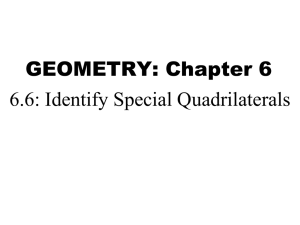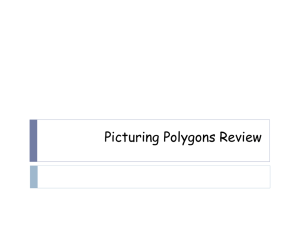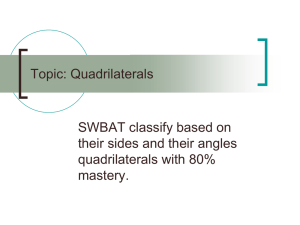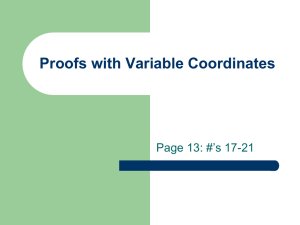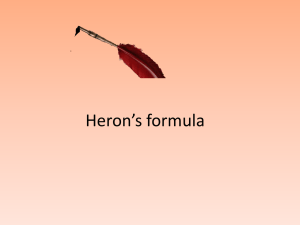Coordinate geometry: working with slopes
advertisement
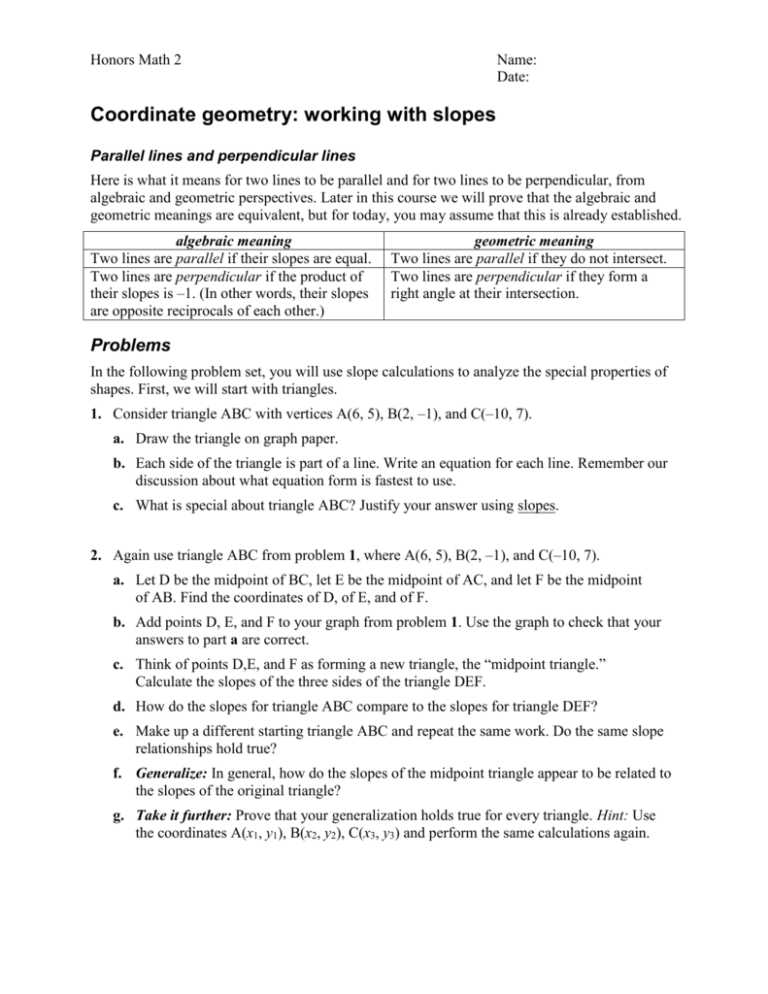
Honors Math 2 Name: Date: Coordinate geometry: working with slopes Parallel lines and perpendicular lines Here is what it means for two lines to be parallel and for two lines to be perpendicular, from algebraic and geometric perspectives. Later in this course we will prove that the algebraic and geometric meanings are equivalent, but for today, you may assume that this is already established. algebraic meaning Two lines are parallel if their slopes are equal. Two lines are perpendicular if the product of their slopes is –1. (In other words, their slopes are opposite reciprocals of each other.) geometric meaning Two lines are parallel if they do not intersect. Two lines are perpendicular if they form a right angle at their intersection. Problems In the following problem set, you will use slope calculations to analyze the special properties of shapes. First, we will start with triangles. 1. Consider triangle ABC with vertices A(6, 5), B(2, –1), and C(–10, 7). a. Draw the triangle on graph paper. b. Each side of the triangle is part of a line. Write an equation for each line. Remember our discussion about what equation form is fastest to use. c. What is special about triangle ABC? Justify your answer using slopes. 2. Again use triangle ABC from problem 1, where A(6, 5), B(2, –1), and C(–10, 7). a. Let D be the midpoint of BC, let E be the midpoint of AC, and let F be the midpoint of AB. Find the coordinates of D, of E, and of F. b. Add points D, E, and F to your graph from problem 1. Use the graph to check that your answers to part a are correct. c. Think of points D,E, and F as forming a new triangle, the “midpoint triangle.” Calculate the slopes of the three sides of the triangle DEF. d. How do the slopes for triangle ABC compare to the slopes for triangle DEF? e. Make up a different starting triangle ABC and repeat the same work. Do the same slope relationships hold true? f. Generalize: In general, how do the slopes of the midpoint triangle appear to be related to the slopes of the original triangle? g. Take it further: Prove that your generalization holds true for every triangle. Hint: Use the coordinates A(x1, y1), B(x2, y2), C(x3, y3) and perform the same calculations again. In the rest of the problems, you will use slope calculations to analyze the special properties of quadrilaterals (four-sided shapes). For example, a quadrilateral might be a parallelogram, a trapezoid, a rectangle, a rhombus, a square, or none of these, depending on the slopes and lengths of its sides. Definitions of special types of quadrilaterals A parallelogram is a quadrilateral (four-sided shape) with two pairs of parallel sides. A trapezoid is a quadrilateral with only one pair of parallel sides. A rectangle is a quadrilateral with right angles at all four vertices (corners). A rhombus is a quadrilateral with all four sides being equal in length. A square is a quadrilateral that is both a rectangle and a rhombus. 3. Consider quadrilateral WXYZ with vertices W(–2, 3), X(–1, 8), Y(9, 6), and Z(8, 1). Is this quadrilateral a parallelogram? A trapezoid? A rectangle? A rhombus? A square? Justify your answer using slopes and distances. 4. Consider quadrilateral STUV with vertices S(0, 2), T(2, 6), U(6, 4), and V(2, 1). a. How many right angles does STUV have? Justify your answer using slopes. b. Prove that STUV is a trapezoid. 5. Consider quadrilateral ABCD with vertices A(4, 8), B(2, 2), C(8, 0), and D(10, 6). Is this quadrilateral a parallelogram? A trapezoid? A rectangle? A rhombus? A square? Justify your answer using slopes and distances. 6. Consider quadrilateral OPQR with O(2, 0), P(8, 4), Q(5, 8), and R(2, 6). a. Is quadrilateral OPQR a parallelogram? A trapezoid? A rectangle? A rhombus? A square? Justify your answer using slopes and distances. b. Let K, L, M, and N stand for the midpoints of OP, PQ, QR, and RO. Calculate the coordinates of these four points. c. Graph the quadrilateral and its midpoints on graph paper. Use your graph to check your answers to part b. d. Think of points K, L, M, and N as forming a new quadrilateral, the “midpoint quadrilateral.” Using slopes and distances, determine what type of special quadrilateral (if any) KLMN is. e. Take it further: Prove a fact about midpoint quadrilaterals in general. 7. Graph quadrilateral GHIJ with G( 2 , 4), H(3, 3), I( 2 , –4), and J(–3, –3). How many right angles does it have? Prove your answer. 8. Using slopes, prove that every rectangle must be a parallelogram. (Notice that our definition of rectangle doesn’t assume it is a parallelogram, so we must prove it.) Hints: *Let m1, m2, m3, and m4 stand for the slopes of the four sides (going consecutively around the rectangle). *We know that m1 ∙ m2 = –1, m2 ∙ m3 = –1, m3 ∙ m4 = –1, and m4 ∙ m1 = –1. (How do we know this?) *What you need to prove is that m1 = m3 and m2 = m4.
